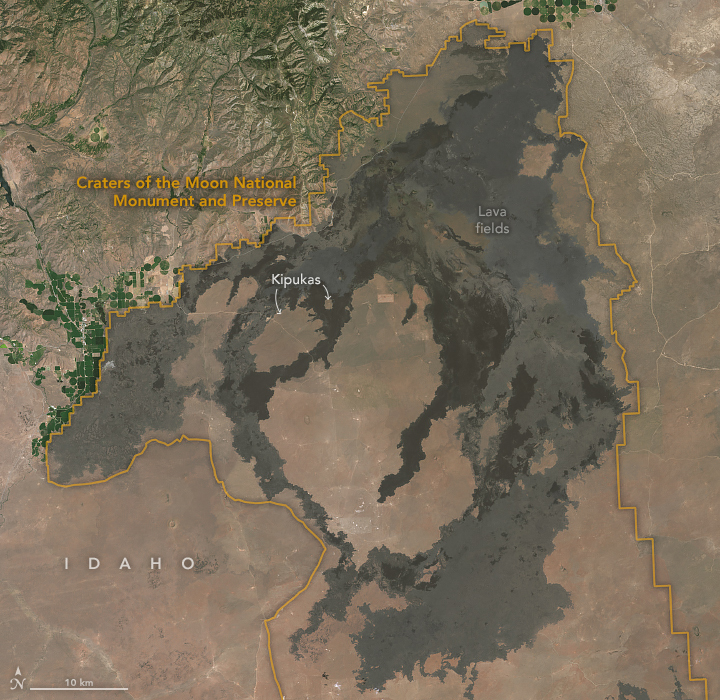
Moonscapes of Idaho
Downloads
- idaho_cratersmoonnp_oli_20240707_lrg.jpg (2446x2378, JPEG)
- idaho_cratersmoonnp_oli2_20250123_lrg.jpg (2446x2378, JPEG)
- cratersmoon_lava_pho_lrg.jpg (3759x2703, JPEG)
- cratersmoon_astronauts_nasa_pho_lrg.jpg (3057x2444, JPEG)
Metadata
- Sensor(s):
- Landsat 8 - OLI
- Landsat 9 - OLI-2
- Data Date: July 7, 2024 - January 23, 2025
- Visualization Date: April 23, 2025
In summer 1969, four astronauts from NASA’s Apollo program visited Craters of the Moon National Monument and Preserve in southern Idaho. Trained as pilots, not geologists, the astronauts were there to study the volcanic landscape—similar to what they might encounter on the Moon—and learn field geology techniques in preparation for their investigation and sampling of the lunar surface.
Like the surface of the Moon, the national monument in Idaho is covered in fields of lava. While most of the Moon’s volcanism occurred more than 1 billion years ago, the lava flows in Craters of the Moon are quite young: between 15,000 and 2,100 years old. They erupted from a series of fissures over 50 miles (80 kilometers) long known as the Great Rift to create an expanse of dark basaltic rock.
The lava fields of Craters of the Moon are shown in the images above in summer (left) and winter (right). They were acquired with the OLI (Operational Land Imager) on Landsat 8 in July 2024 and the OLI-2 on Landsat 9 in January 2025, respectively. The photos below show this moonscape from the ground in 2024 and in 1969 (bottom of the page), when astronauts Eugene Cernan and Joe Engle were working with NASA geologist Ted Foss.
The assemblage of lava flows in the area contains nearly every type of volcanic feature associated with basaltic eruptions. Many, including lava tubes and three distinct types of ropy pahoehoe lava, are too small to be visible at the scale of these images. A number of cinder cones—conical hills formed when gas-filled magma erupted in fiery fountains—stand out in the snowy winter scene above. These features are usually topped by a prominent crater. (Note that the craters of Craters of the Moon are volcanic in origin, whereas the round depressions on Earth’s Moon formed when meteoroids, asteroids, and comets struck its surface.)
The area’s ecology is closely connected to the volcanic landscape. Lichens are some of the first organisms to colonize new lava flows, and plants gradually find places to grow in the cracks in the lava. Sagebrush is common in the park, especially where rocks are older and soil is more developed.
Islands of lusher plant life called kipukas are scattered throughout the region, becoming isolated when lava flowed around elevated patches of land. Hundreds exist in the park, ranging in size from less than one acre to tens of thousands of acres. Larger kipukas may be crisscrossed by roads and altered by other human activity, while smaller ones are relatively undisturbed. These ecological havens contain some of the oldest juniper trees in Idaho and are valuable for long-term scientific study.
The plant and animal life here, in addition to coexisting with lava rock, must also endure long winters. At approximately 6,000 feet (1,800 meters) in elevation, the area can experience cold, snowy conditions from November through March.
In the decades since the Apollo program, Craters of the Moon has continued to garner interest from scientists for its commonalities not only with the Moon but also with Mars. Subsequent research programs have used the lava landscape to test instrumentation and advance our planetary exploration capabilities. In one recent study, researchers pointed out that Craters of the Moon lava tubes support diverse microbial communities and have some structural similarities to lava tubes on Mars. These Martian features, shielded from less hospitable surface environments, are of particular interest to scientists because of their potential to harbor biological communities.
Editor’s Note: Explore satellite imagery of other national parks for National Park Week.
References
- Hughes, S. S., et al. (2019) Basaltic Terrains in Idaho and Hawai‘i as Planetary Analogs for Mars Geology and Astrobiology, Astrobiology, 19:3, 260-283.
- NASA Moon Facts. Accessed April 23, 2025.
- NASA Planetary Analogs. Accessed April 23, 2025.
- NASA (2015, November) Science Training History of the Apollo Astronauts. Accessed April 23, 2025.
- National Park Service (2022, March 5) Craters of the Moon National Monument & Preserve. Accessed April 23, 2025.
- National Park Service (2024, April 4) Life Among the Lava Flows. Accessed April 23, 2025.
- National Park Service (2024, September 25) National Monument Unveils the Scientific Secrets of the Moon on Earth. Accessed April 23, 2025.
- National Park Service (2024, June 14) NPS Geodiversity Atlas—Craters Of The Moon National Monument & Preserve, Idaho. Accessed April 23, 2025.
- Smithsonian Channel (2022, March 19) Why NASA Loves this Idaho National Monument Landscape. Accessed April 23, 2025.
- Weng, M. M., et al. (2022) Life Underground: Investigating Microbial Communities and Their Biomarkers in Mars-Analog Lava Tubes at Craters of the Moon National Monument and Preserve. Journal of Geophysical Research: Planets, 127(11), e2022JE007268.
NASA Earth Observatory images by Michala Garrison, using Landsat data from the U.S. Geological Survey. Photo of NASA geologist Ted Foss and astronauts Eugene Cernan and Joe Engle by NASA. Story and 2024 photo of Craters of the Moon lava and cinder cone by Lindsey Doermann.
This image record originally appeared on the Earth Observatory. Click here to view the full, original record.

